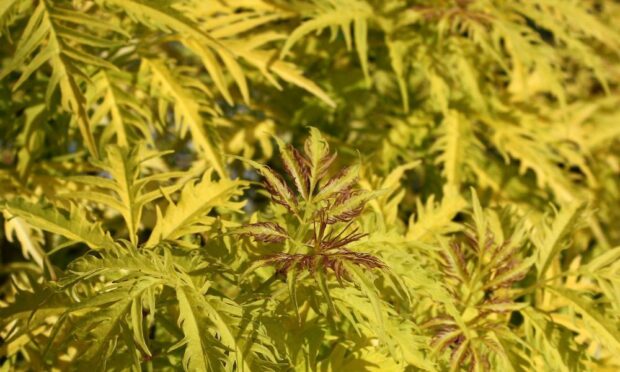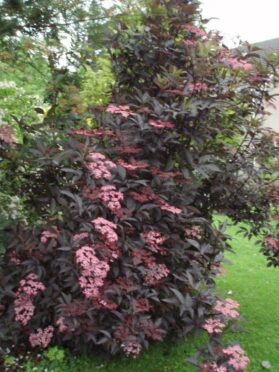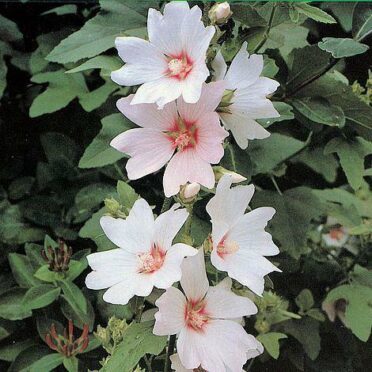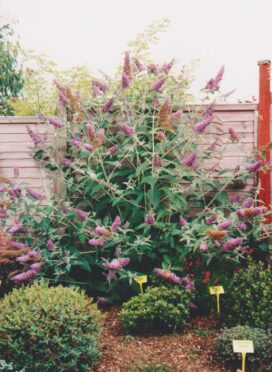Many late summer flowering shrubs, like Buddleia davidii, produce their flowers on long, thin stems, hence they are prone to damage during these very windy spells we have been having lately, especially if they are planted in open, windy sites.
With more windy weather likely to come along, it would be prudent to cut back these tall, woody stems to reduce the chances of damage and perhaps even subsequent wind-rocking, causing damage to the root system.
As well as the Buddleia and its various varieties, I might mention Lavatera (Tree Mallow), some Roses, the very attractive Rhus typhina which I featured last week and a shrub I missed out when referring to autumn fruits – the Elderberry!
I have a couple of its relatives – Sambucus ‘Black Lace’ and Sambucus Sutherland Gold at the front of the house, grown primarily for their foliage colour and flowers.
I have never seen them produce berries hence the omission.
You can safely cut back these tall, elegant shrubs, growing to over two metres tall, to about a third of their present height, then, come spring, they can be trimmed back further as new growth starts to appear.
As the saying goes, old habits die hard, and this week my mind turns to one that is forever hitting the headlines these days – plastic waste.
Turning the clock back to the Fifties, we used wooden trays for seed sowing and pricking out seedlings.
Plants were planted into clay pots. Plastic containers hadn’t been heard of.
I can remember yet, on winter mornings, as a beginner, standing in an unheated shed, by a large tub scrubbing 10-inch clay pots in water which started warm but quickly cooled off but wasn’t reheated.
There were hundreds of these pots to be cleaned, for use again in the new season.
We used them for growing Chrysanthemums, a major cut flower crop on the nursery. When we did come to fill these quite weighty monsters, it was with John Innes Compost which consisted of seven parts loam, three parts peat and two parts sand – by volume.
Even before they were watered, they were heavy to be humphed off and on barrows. (No wonder plastic pots and soilless composts became so popular, so quickly.)
Needless to say, these two changes were driven by commercial necessity.
During the Sixties and Seventies we saw the emergence of a year-round market for pot grown trees and shrubs to supplement the traditional bare root trade which, of course, could only be practised in the dormant season.
But initially the trade in pot-grown trees and shrubs proved to be very expensive because of the distribution costs.
The weight of plants in clay pots full of a soil-based compost made transport costs uneconomical.
The commercial fact is, plants growing in plastic pots filled with soilless compost were hugely successful. That said, the ‘bare-root’ dormant season trade is still used.
The use of plastic material has been so successful, not only in the horticultural industry, that it has now become a nuisance causing all sorts of problems, particularly affecting our environment.
Fortunately, these clever scientists are working on ways and means of producing a plastic that is biodegradable and it behoves all of us to sign up to following the associated rules for disposing of these containers.
I have to say, these thoughts came to me as I was planting out some new polyanthus the other day. Bought from the garden centre, the plants were in plastic units which will now be disposed of in the proper manner.
Meantime all my potting is into plastic pots which I have accumulated over the years. When they have been emptied, they are washed clean and stacked for subsequent use, a comparatively simple and painless job compared with clay pots in days of yore.
Many colleagues and chums have turned to using redundant plastic containers which have carried food stuffs, not to mention toilet roll tubes. I don’t need to but I can see the day…
I’ve had some peculiar holes appear on the lawn lately, similar to the scuff mark made by golfers as they ‘swing through the ball’.
For the world of me I can’t think of the cause. We do have visits from a large family dog from time to time but he is reasonably well behaved and we are visited by several uninvited cats who head for the areas where the bird feeders are located but I don’t think they are to blame either. Could it be mice? I will report in due course if I solve the problem but funnily enough, I had a call the other day from a chum who has had a problem with mice in the garden but he seems to have solved the problem.
We are talking about 12 -15 of the wee blighters caught in a matter of a few days. The bait in the trap is a halved Malteaser.













